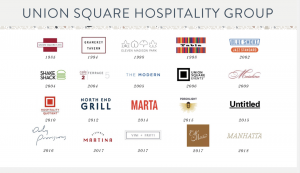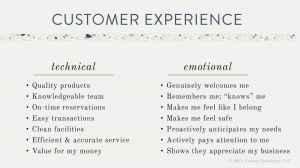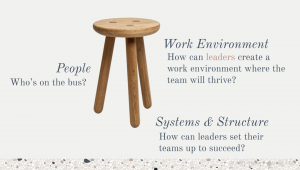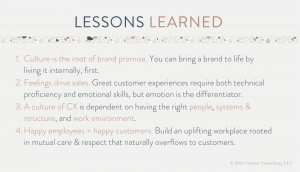DesignOps Summit 2021 – Culture as the Root of Brand Promise (Susan Salgado)
Founder, Grayson Consulting
I’m going to share with you some thoughts and ideas about customer experience as they come from the hospitality world
It is my passion to think about happy employees and happy customers and how those two are linked to one another.
- My history has been working in restaurants focusing on Organizational Culture and Leadership
- Specifically with this restaurant group, Union Square hospitality group in New York City, which was founded by Danny Meyer in 1985 (ex: Shake Shack)

I was looking for a place to study the idea that happy employees lead to happy customers.
It was intuitive to me and made sense
- I wasn’t finding that the research that’s out there actually supported that notion, and I thought that doesn’t make sense.
- Whenever I went to Union Square Café I would talk to the bartenders and servers, and I was always so impressed by how passionate they were about food and wine and making delightful experiences for other people
Danny was opening Eleven Madison Park and Tabla
- Media going crazy, saying Danny Myers revolutionizing the restaurant industry and the way we eat in restaurants
- He was creating fine dining that was accessible without pretense
- He was known for creating great work environments where people were thriving and loved their jobs.
I met with Danny and he agreed that I could use his restaurants to help write my dissertation research BUT there was one caveat
- I had to work in the restaurant first because they I hadn’t worked in a restaurant before and they wanted me to learn their organization from the inside out.
- In November 1999 I started working at Union Square Cafe as a host reservationist and we were opening the reservation books for December 1999
I go into my first day of work and the General Manager wants to meet with me
- I’m thinking, I’m a reservationist, why is the GM meeting with me?
- He wanted to make sure I really understand what I’m going to be doing here
- GM: Let’s talk about your job – What do you think you’ll be doing?
- Me: Answering phones and taking down reservations
- GM: Yes, that’s what you’ll be doing but that’s NOT your job. Your job is to make them want to call back again
What makes for an ideal customer experience?

A lot of responses she received for – What makes for an ideal customer experience?
- “I was remembered” – they remembered their faces and details about their life.
- Made them feel special and welcomed, sense of belonging
- Appreciation of my business
At the end of the day, we want to feel like we’re getting great value for our money
2 Core components to customer experience – Technical vs. Emotional
Regardless of what industry you’re in, whatever product you’re selling, it doesn’t matter
We must deliver on both the technical side of the equation and the emotional side of the equation
Restaurant Example:
- Technical Side
- Getting the right food to the right person at the right temperature at the right time
- Do you have everything you need to enjoy your meal?
- Emotional Side
- How they make me feel when I’m dining in the restaurant
What differentiates a business and makes it stand out from the others in the industry?
Emotion is the competitive advantage
- You can copy other restaurants, but you can’t copy emotions like how the people make you feel when you’re dinging at their restaurant
Competitive Advantage
- To gain advantage in any business, you have something unique that other people don’t have
- Not just about restaurants, and it’s external customers, but also about internal customers
- Think about how we work on the teams and how we collaborate with one another – each one of us has an internal customer because we rely on people in other areas of our departments to help us accomplish our goal each day
- For teams to be effectively working together – each person on the team needs to be able to deliver on the technical side of the equation and on the emotional side
Technical
- In other words, you need to be good at your job and maybe even know what other people need around you so that you can make people’s jobs easier by doing your job better that
Emotional
- We should be people others want to work with
-
- Collaborative and thoughtful
- Good team members who are empathetic and treat others with respect leads to better teamwork and cohesiveness
-
It’s not just about WHAT you do, it’s also about how we make people FEEL
How can great culture lead to great customer experiences?
What is Organizational Culture?
Organizational Cultures
12 Components of Organizational Cultures: Values, rituals, history, hierarchy, beliefs, traditions, heroes, language, norms, attire, legends, and acceptable behaviors
- There are a lot of misnomers out there about what organizational culture is
- People have started to talk about nap rooms and beer kegs and all these amenities
- Amenities are important and can help make employees feel valued and make their lives a little bit nicer but that’s not what culture is about
Organizational Culture Example: How families and communities raise kids
- Someone must teach them what’s right and wrong – share a belief system with them
- Teach them norms – like you wipe your feet before you come in the door and make eye contact
- We teach our children these norms, beliefs and values and reinforce them through things like rituals and traditions
- Rituals – holiday celebrations
- Tradition – yearly vacations
- Continue to perpetuate culture by talking about our history and the heroes of our family
- The Legends of Help things happened.
We have all these elements of culture that at the end of the day will lead down to acceptable behavior
What is OK to do? How do we treat one another? And how will they learn this?
- By being immersed in it
- They grow up in it and they watch everything that’s going on around them and they see what acceptable behavior looks like because it gets rewarded, and they see what unacceptable behavior looks like because it gets reprimanded or punished
The same principles apply to organizations
- When we onboard new employees it is their senior employees responsibility to inform them about the company culture
- Help them understand:
- Why this company was started and what you’re trying to accomplish
- What you contribute to the world?
- Who are the heroes and legends in that story?
- What does acceptable behavior look like?
- How do we talk to each other?
- How do we email each other?
- What does it look like when we’re in meetings?
Everyone has culture
Whenever you have a group of people who get together culture just naturally forms
- If there are no senior people to designate what that culture should look like the employees will form the culture themselves by what behavior is acceptable
- Accountability to your standards and your values is essential to ensure that your culture is strong and that it is in enduring overtime
- If we don’t reinforce those values by talking about them and rewarding and reprimanding behaviors, the culture will start to shift to whatever the employees can get away with
Reinforcement of the company values is important because without it the employees will start to think it doesn’t matter
- Leaders are not the only ones who can hold people accountable, other employees/your peers can keep you in check because culture becomes cognitive
- It’s just the way we think and do things and because of that everyone follows those norms
They do what they’re supposed to do, without being told or mandated because they believe in it and that alignment of values will bring out the best in your team and really make for a strong
How do you build infrastructure to support a culture of CX?

In my research I have found that there are 3 core components to creating a great customer experience and I look for these components every time I go into an organization to do consulting work on organizational culture
People – Who’s on the bus?
- Thinking about your people – Do you have the right people in the right seats on the bus?
- They need to be culturally aligned and they need to be competent to do their jobs
- There are technical and emotional components to think about when hiring new employees
- Technical – Do they have the right skills? Are they going to be successful in their achievements?
- Emotional – Do they fit into our culture? Do they have the same values? Do they have the emotional capacity to be a good team member?
- We all have front and back of house in our businesses and you can’t just focus on the people who are customer facing when you think about creating a great culture
- Example: If we have a server go into the kitchen to ask the line cook to make a substitution on a dish and get yelled at by the line cook, they will not be able to go back out in the dining room and be genuinely warm and caring for the guests
- People are not wired that way – We carry that negative energy with us so there needs to be a focus on these emotional skills and having great cultural alignment of everyone on the team
- Finally, we must be willing to offload people who don’t belong in the org anymore
Systems and Structures – How can leaders set their teams up to succeed?
- This applies to everything from your technology to protocols, policies, and your job descriptions
- Do people really understand how work gets done? How it transfers one person to the next?
- If we are scrambling with poor systems and structure, where people don’t know how to get things done – It takes away from our bandwidth that would otherwise enable us to focus on the emotional aspects of customer service
- We need to have great preparation and great technical setup to execute seamlessly
Work Environment – The quality of the work environment
- Are people thriving at work? Do they love their jobs? Do they get the Monday morning blues?
- Even if their jobs are exhausting or time consuming, you know you’re really succeeding when the people love to come to work

Lessons Learned
- Culture is the root of brand promise – You can bring a brand to life by living it internally, first
- Feelings drive sales – Great customer experiences require both technical proficiency and emotional skills, but emotion is the differentiator
- A culture of CX is dependent on having the right people, systems & structure, and work environment
- Happy employees = Happy customers – Build an uplifting workplace rooted in mutual care and respect that naturally overflows the customers
Leadership can overcome challenges in the people and systems & structures
Organizations must continue to invest in their leaders

